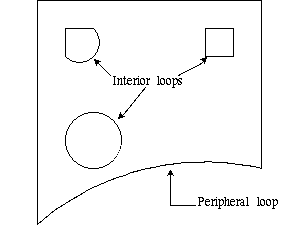Example
The following code creates a bounded plane with three interior hole
loops. Thus, there are a total of four curve string loops. The figure
that follows illustrates the results of the example C program.

Figure Bounded Plane Feature
#include <stdio.h>
#include <string.h>
#include <uf.h>
#include <uf_modl.h>
#include <uf_curve.h>
#include <uf_part.h>
#include <uf_csys.h>
#define UF_CALL(X) (report( __FILE__, __LINE__, #X, (X)))
static int report( char *file, int line, char *call, int irc)
{
if (irc)
{
char messg[133];
printf("%s, line %d: %s\n", file, line, call);
(UF_get_fail_message(irc, messg)) ?
printf(" returned a %d\n", irc) :
printf(" returned error %d: %s\n", irc, messg);
}
return(irc);
}
static void do_ugopen_api(void)
{
/* bounded plane edge tolerance */
double tol[3];
/* data points for objects in loops */
static double points[45] = { 4.,-2.,0.,4.,4.,0.,-4.,4.,0.,-4.,
-4.,0.,0.,-2.,0.,-2.,3.,0.,-3.,3.,0.,-3.,2.,0.,
-2.,2.,0.,-2.,-1.,0.,2.,3.,0.,3.,3.,0.,3.,2.,0.,
2.,2.,0.,2.,3.,0.};
static double startang = 0.0;
static double endang = 6.28318530717958648;
static double arcrad = 1.0;
char prtnam[133];
int loops[4];
int numlps = 4;
int units =2;
int arc = 1;
int k, total;
tag_t bpobj;
tag_t part;
tag_t objarray1[4];
tag_t objarray2[3];
tag_t objarray3, wcs_tag;
tag_t objarray4[4];
UF_STRING_t generator;
UF_STRING_p_t ge = &generator;
UF_CURVE_line_t line1;
UF_CURVE_line_t line2;
UF_CURVE_line_t line3;
UF_CURVE_line_t line4;
UF_CURVE_line_t line5;
UF_CURVE_line_t line6;
UF_CURVE_line_t line7;
UF_CURVE_line_t line8;
UF_CURVE_line_t line9;
UF_CURVE_arc_t arc1;
line1.start_point[0] = points[3];
line1.start_point[1] = points[4];
line1.start_point[2] = points[5];
line1.end_point[0] = points[0];
line1.end_point[1] = points[1];
line1.end_point[2] = points[2];
line2.start_point[0] = points[6];
line2.start_point[1] = points[7];
line2.start_point[2] = points[8];
line2.end_point[0] = points[3];
line2.end_point[1] = points[4];
line2.end_point[2] = points[5];
line3.start_point[0] = points[9];
line3.start_point[1] = points[10];
line3.start_point[2] = points[11];
line3.end_point[0] = points[6];
line3.end_point[1] = points[7];
line3.end_point[2] = points[8];
line4.start_point[0] = points[15];
line4.start_point[1] = points[16];
line4.start_point[2] = points[17];
line4.end_point[0] = points[18];
line4.end_point[1] = points[19];
line4.end_point[2] = points[20];
line5.start_point[0] = points[18];
line5.start_point[1] = points[19];
line5.start_point[2] = points[20];
line5.end_point[0] = points[21];
line5.end_point[1] = points[22];
line5.end_point[2] = points[23];
line6.start_point[0] = points[30];
line6.start_point[1] = points[31];
line6.start_point[2] = points[32];
line6.end_point[0] = points[33];
line6.end_point[1] = points[34];
line6.end_point[2] = points[35];
line7.start_point[0] = points[33];
line7.start_point[1] = points[34];
line7.start_point[2] = points[35];
line7.end_point[0] = points[36];
line7.end_point[1] = points[37];
line7.end_point[2] = points[38];
line8.start_point[0] = points[36];
line8.start_point[1] = points[37];
line8.start_point[2] = points[38];
line8.end_point[0] = points[39];
line8.end_point[1] = points[40];
line8.end_point[2] = points[41];
line9.start_point[0] = points[39];
line9.start_point[1] = points[40];
line9.start_point[2] = points[41];
line9.end_point[0] = points[42];
line9.end_point[1] = points[43];
line9.end_point[2] = points[44];
arc1.start_angle = startang;
arc1.end_angle = endang;
arc1.arc_center[0] = points[27];
arc1.arc_center[1] = points[28];
arc1.arc_center[2] = points[29];
arc1.radius = arcrad;
strcpy(prtnam,"bplane");
UF_CALL(UF_PART_new(prtnam,units,&part));
UF_CALL(UF_CSYS_ask_wcs(&wcs_tag));
UF_CALL(UF_CSYS_ask_matrix_of_object(wcs_tag, &arc1.matrix_tag));
/* Create geometry for a bounded plane */
/* 1 peripheral loop and 3 hole loops */
/* Set up loop 1 - peripheral boundary - 3 lines and an arc */
loops[0] = 4;
UF_CALL(UF_CURVE_create_line(&line1, &objarray1[0]));
UF_CALL(UF_CURVE_create_line(&line2, &objarray1[1]));
UF_CALL(UF_CURVE_create_line(&line3, &objarray1[2]));
FTN(uf5063)(&arc, points, &points[12], &points[9],
&objarray1[3]);
/* Set up loop 2 - hole - 2 lines and an arc */
loops[1] = 3;
UF_CALL(UF_CURVE_create_line(&line4, &objarray2[0]));
UF_CALL(UF_CURVE_create_line(&line5, &objarray2[1]));
FTN(uf5063)(&arc, &points[21], &points[24], &points[15],
&objarray2[2]);
/* Set up loop 3 - hole - single arc */
loops[2] = 1;
UF_CALL(UF_CURVE_create_arc(&arc1, &objarray3));
/* Set up loop 4 - hole - 4 lines */
loops[3] = 4;
UF_CALL(UF_CURVE_create_line(&line6, &objarray4[0]));
UF_CALL(UF_CURVE_create_line(&line7, &objarray4[1]));
UF_CALL(UF_CURVE_create_line(&line8, &objarray4[2]));
UF_CALL(UF_CURVE_create_line(&line9, &objarray4[3]));
UF_MODL_init_string_list(ge);
UF_MODL_create_string_list(numlps,12,ge);
/* Store section loop data into string list structure. */
total = 0;
ge->string[0] = loops[0];
ge->dir[0] = 1;
for (k = 0; k < loops[0]; k++) ge->id[total++] = objarray1[k];
ge->string[1] = loops[1];
ge->dir[1] = -1;
for (k = 0; k < loops[1]; k++) ge->id[total++] = objarray2[k];
ge->string[2] = loops[2];
ge->dir[2] = 1;
ge->id[total++] = objarray3;
ge->string[3] = loops[3];
ge->dir[3] = -1;
for (k = 0; k < loops[3]; k++) ge->id[total++] = objarray4[k];
if (total != 12) printf("Error in total value!\n");
tol[0] = .001;
tol[1] = .5 * (PI/180);
tol[2] = .02;
/* Create a bounded plane */
UF_CALL(UF_MODL_create_bplane(ge,tol,&bpobj));
UF_MODL_free_string_list(ge);
}
/*ARGSUSED*/
void ufusr(char *param, int *retcode, int paramLen)
{
if (!UF_CALL(UF_initialize()))
{
do_ugopen_api();
UF_CALL(UF_terminate());
}
}
int ufusr_ask_unload(void)
{
return (UF_UNLOAD_IMMEDIATELY);
}
